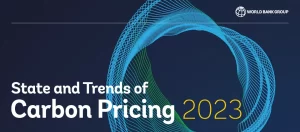World Bank: Carbon Markets Resilient in a High-Pressure 2022, with Seismic Changes Afoot

Emissions trading systems and carbon taxes showed themselves to be resilient in the last year. Despite a global energy crisis, high inflation, and fiscal pressures, emissions trading systems (ETSs) and carbon taxes posted record high revenues, according to the World Bank’s just-released State and Trends in Carbon Pricing 2023.
Through our partnership with the World Bank, Ecosystem Marketplace (EM) provided an early cut of our 2022 voluntary carbon market (VCM) trade data, representing a subset of all EM Respondents who had disclosed their carbon credit sales data through our new EM Global Carbon Markets Hub in time for this report’s data lock.
Among the key findings of the report:
- The price differential between OTC and exchanges is widening. We continue to see a divergence between over-the-counter (OTC) and exchange-traded markets. In 2022, exchange-traded credit prices fell. But OTC market participants tracked in this report saw their credit prices increase by a massive 70%, averaging $6.83/ton in 2022. It’s important to note that this is a preliminary figure based on a subset of the overall market; EM’s forthcoming State of the Voluntary Carbon Market will include our complete and final 2022 data.
- The number of implemented ETSs and carbon taxes now stands at 77, with the share of global GHG emissions covered around 23%. In 2022, a number of jurisdictions either delivered on existing plans for new ETSs or taxes, increased their ambition, or announced further proposals for developing new initiatives in the coming years. While the uptake of ETSs and carbon taxes is on the rise in emerging economies, high-income countries still dominate.
- Record high revenues from ETSs and carbon taxes approached USD 100 billion. Almost 40% of the revenue is earmarked for green spending, and 10% is used to compensate households or businesses – both are seen as a way to increase support for these policies.
- Still, carbon markets remain overwhelmingly driven by voluntary demand. The vast majority of retirements continue to come from voluntary, not compliance, buyers.
- After two years of rapid growth, carbon credit markets slowed in 2022. EM data showed a 1.3% decline in overall retirements from 2021, with 196 million credits retired in 2022.
- Nature-based solutions show signs of overtaking renewable energy for market share. Renewable energy has historically dominated market supply, and it still does: the share of carbon credits issued from renewable energy activities has been trending upward since 2018, accounting for 55% of issuances in 2022. However, we’ve seen the cost of renewable energy fall dramatically over the last decade – which means that carbon revenues are increasingly less necessary to make investments in renewable energy economically attractive, presaging a dwindling down of RE credits in the carbon markets. Meanwhile EM data shows that 54% of new project registrations in 2022 were for forestry and land use projects. Caveat: forestry and land use credits issuances have risen and fallen in recent years. EM saw a substantial drop in both absolute and relative terms in 2022. But the registration data suggests another expansion is on the horizon. Still, don’t count RE out just yet: in 2022, 52% of credit retirements were from renewable energy projects, up from 44% in 2021. RE credits are still widely available, and among the least expensive credit type.
- The carbon credit market continues to grow in diversity and sophistication, as new investors, financial products, technological platforms, and service providers lay the foundations for what some expect will be a decade of significant growth. Article 6 implementation also continues to advance as more countries sign bilateral cooperation agreements and the first activities to generate authorized emissions reductions are developed. And new integrity initiatives are promising to promote standardization and improve transparency in carbon credit market.
Learn more and download the State and Trends of Carbon Pricing 2023 from the World Bank here.
Please see our Reprint Guidelines for details on republishing our articles.

